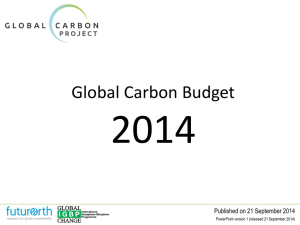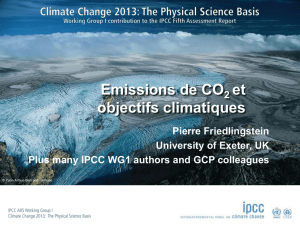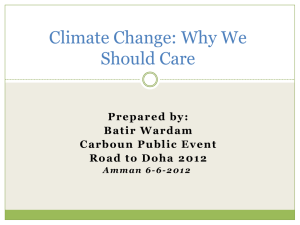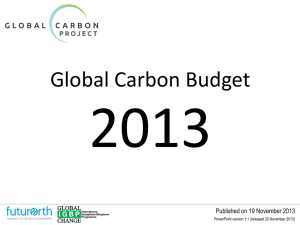Lecture 1B
advertisement
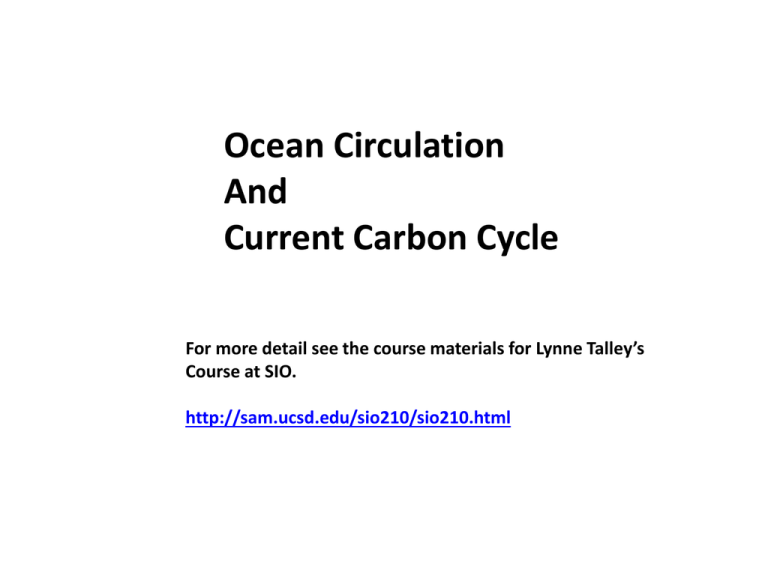
Ocean Circulation And Current Carbon Cycle For more detail see the course materials for Lynne Talley’s Course at SIO. http://sam.ucsd.edu/sio210/sio210.html World’s Oceans Surface Currents Conveyor Belt North Atlantic Deep water Abyssal Circulation is topographically controlled Surface density, isopycnal outcrops Waters will move mostly along surfaces of constant density. Sea Surface Salinity Q. Why does surface salinity vary? DS = 30 to 37 What are broad patterns and what controls salinity? Sea Surface Temperature (SST) N-S Cross Sections Atlantic Ocean 10 22 N-S Cross Sections in the Pacific Ocean 11 23 Salinity Cross Section in Altantic Ocean Salinity Cross Section (Pacific Ocean) Cross Section of Pot. Temp in Atlantic Ocean Ocean Warming Purkey and Johnson 2010 J. Climate, 23, 6336 Rates of freshwater inventory change within the Antarctic Bottom Water (AABW). Purkey and Johnson, 2013. J. Climate, 26 Global Carbon Budget 2014 Published on 21 September 2014 PowerPoint version 1 (released 21 September 2014) Fossil Fuel and Cement Emissions Global fossil fuel and cement emissions: 36.1 ± 1.8 GtCO2 in 2013, 61% over 1990 Projection for 2014 : 37.0 ± 1.9 GtCO2, 65% over 1990 Uncertainty is ±5% for one standard deviation (IPCC “likely” range) Estimates for 2011, 2012, and 2013 are preliminary Source: CDIAC; Le Quéré et al 2014; Global Carbon Budget 2014 Sarmiento and Gruber (2002) Sinks for Anthropogenic Carbon Physics Today August 2002 30-36 Observed Emissions and Emissions Scenarios Emissions are on track for 3.2–5.4ºC “likely” increase in temperature above pre-industrial Large and sustained mitigation is required to keep below 2ºC Data: CDIAC/GCP/IPCC/Fuss et al 2014 Over 1000 scenarios from the IPCC Fifth Assessment Report are shown Source: Fuss et al 2014; CDIAC; Global Carbon Budget 2014 Top Fossil Fuel Emitters (Absolute) The top four emitters in 2013 covered 58% of global emissions China (28%), United States (14%), EU28 (10%), India (7%) Bunkers fuel used for international transport is 3% of global emissions Statistical differences between the global estimates and sum of national totals is 3% of global emissions Source: CDIAC; Le Quéré et al 2014; Global Carbon Budget 2014 Top Fossil Fuel Emitters (Per Capita) China’s per capita emissions have passed the EU28 and are 45% above the global average Per capita emissions in 2013 Source: CDIAC; Le Quéré et al 2014; Global Carbon Budget 2014 Emissions from Coal, Oil, Gas, Cement Share of global emissions in 2013: coal (43%), oil (33%), gas (18%), cement (6%), flaring (1%, not shown) Source: CDIAC; Le Quéré et al 2014; Global Carbon Budget 2014 Anthropogenic Perturbation of the Global Carbon Cycle Perturbation of the global carbon cycle caused by anthropogenic activities, averaged globally for the decade 2004–2013 (GtCO2/yr) Data: CDIAC/NOAA-ESRL/GCP Source: CDIAC; NOAA-ESRL; Le Quéré et al 2014; Global Carbon Budget 2014 Global Carbon Budget Emissions are partitioned between the atmosphere, land, and ocean Source: CDIAC; NOAA-ESRL; Houghton et al 2012; Giglio et al 2013; Joos et al 2013; Khatiwala et al 2013; Le Quéré et al 2014; Global Carbon Budget 2014 Atmospheric Concentration The global CO2 concentration increased from ~277ppm in 1750 to 395ppm in 2013 (up 43%) Mauna Loa registered the first daily measurements above 400pm in May 2013 Globally averaged surface atmospheric CO2 concentration Data from: NOAA-ESRL after 1980; the Scripps Institution of Oceanography before 1980 (harmonised to recent data by adding 0.542ppm) Source: NOAA-ESRL; Scripps Institution of Oceanography; Global Carbon Budget 2014 Persistent Growth – Global Assuming emissions follow projected GDP growth and accounting for improvement in carbon intensity, we project fossil fuel and cement emissions to grow 3.1%/yr to reach 43.2 GtCO2/yr by 2019 Economic growth based on IMF projections, fossil fuel intensity based on 10-year trend Source: CDIAC; Friedlingstein et al 2014 Land-Use Change Emissions Global land-use change emissions are estimated 3.3 ± 1.8 GtCO2 during 2004–2013 The data suggests a general decrease in emissions since 1990 Indonesian peat fires Three different estimation methods have been used, indicated here by different shades of grey Land-use change also emits CH4 and N2O which are not shown here Source: Houghton et al 2012; Giglio et al 2013; Le Quéré et al 2014; Global Carbon Budget 2014 Total Global Emissions Total global emissions: 39.4 ± 3.4 GtCO2 in 2013, 42% over 1990 Percentage land-use change: 36% in 1960, 19% in 1990, 8% in 2013 Three different methods have been used to estimate land-use change emissions, indicated here by different shades of grey Source: CDIAC; Houghton et al 2012; Giglio et al 2013; Le Quéré et al 2014; Global Carbon Budget 2014 Total Global Emissions by Source Land-use change was the dominant source of annual CO2 emissions until around 1950 Coal consumption continues to grow strongly Others: Emissions from cement production and gas flaring Source: CDIAC; Houghton et al 2012; Giglio et al 2013; Le Quéré et al 2014; Global Carbon Budget 2014 Fate of Anthropogenic CO2 Emissions (2004-2013 average) 32.4±1.6 GtCO2/yr 3.3±1.8 GtCO2/yr 91% 9% + 15.8±0.4 GtCO2/yr 44% 10.5±1.8 GtCO2/yr 29% Calculated as the residual of all other flux components 26% 9.4±1.8 GtCO2/yr Source: CDIAC; NOAA-ESRL; Houghton et al 2012; Giglio et al 2013; Le Quéré et al 2014; Global Carbon Budget 2014






